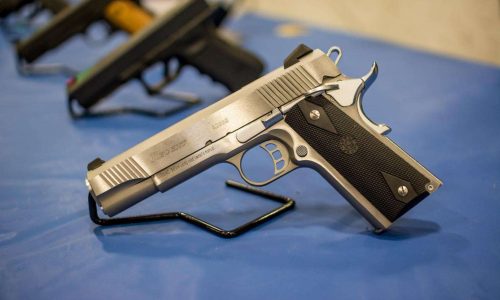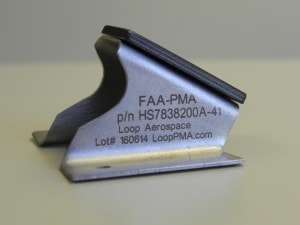The Critical Role of Permanent Marking in Defense Manufacturing?
Permanent marking ensures traceability, security, and compliance in defense manufacturing. From weapons to vehicle components, clear and durable markings prevent misidentification, counterfeiting, and logistical failures.
Why Is Compliance with Military Standards and Regulations Essential?
MIL-STD-130 mandates Unique Item Identifiers (UII) and Direct Part Marking (DPM) for military assets. Compliance ensures supply chain integrity, reduces liability risks, and prevents contract penalties. Reliable marking technologies like fiber laser and dot peen engraving are essential.
How Does Permanent Marking Influence Traceability, Security, and Logistics?
- Traceability – Enables seamless tracking and maintenance.
- Security – Prevents counterfeit parts from entering the supply chain.
- Logistics – Improves inventory management and reduces operational delays.

Challenges in Defense Manufacturing
Ensuring Traceability and Identification of Components
Military components require permanent, readable markings for inventory tracking, maintenance, and compliance. Without proper identification, supply chain inefficiencies and security risks increase.
Maintaining Mark Durability Under Extreme Conditions
Markings must withstand heat, corrosion, and mechanical stress in harsh environments.Dot peen marking ensure long-lasting readability across various military applications.
Adherence to MIL-STD-130 and Other Military Requirements
MIL-STD-130 enforces machine-readable, durable markings like Data Matrix codes and UIIs. Compliance prevents:
- Rejection from military contracts
- Regulatory scrutiny
- Supply chain disruptions
Manufacturers must use high-contrast, scannable, and permanent marking solutions for metals, ceramics, and military-grade plastics.
Permanent Marking Solutions
Overview of Permanent Marking Technologies
Permanent marking solutions ensure that military components remain identifiable, traceable, and compliant with regulations. The most effective methods include:
Laser Marking (Fiber, CO₂, UV) – Provides high-precision, non-contact engraving suitable for metals, plastics, and composites.However, the marking depth is limited.
- Dot Peen Marking – Creates deep, indelible marks through controlled pin impacts, ideal for metal and hard plastic components.
- Chemical Etching – Uses acids or electrolytes to mark surfaces but is less favored in military applications due to limited durability, slower processing, and potential material degradation.
Benefits of Laser Marking and Dot Peen Marking in Defense Applications
- High Precision and Readability – Ensures markings remain scannable even in extreme conditions.
- Tamper-Proof and Corrosion-Resistant – Prevents unauthorized modifications and withstands harsh environments.
- Versatility for Different Materials and Sizes – Suitable for metal, plastic, and composite materials, accommodating a wide range of defense applications.
HeatSign’s Recommended Marking Machines
60W MOPA Fiber Laser Marker (HS-FL60M)
The HS-FL60M is a high-performance 60W MOPA fiber laser marker designed to meet the stringent demands of military applications.
Features and Advantages for Military Applications:
- High-Speed Marking: Ensures efficient processing for large-volume requirements.
- Stable Performance: Delivers consistent and reliable marking results.
- Flexible Marking Range: Standard configurations with options for broader applications.
- Durability: Designed for continuous operation with a theoretical lifespan of up to 100,000 hours.
Compliance with MIL-STD-130 and UID Marking Standards:
The HS-FL60M produces permanent, high-contrast markings that comply with MIL-STD-130 and Unique Identification (UID) requirements, ensuring traceability and identification of military assets.
High-Speed, High-Contrast Marking for Metals and Composites:
With its enhanced power, the HS-FL60M is capable of deep engraving on metals and efficient marking on ceramics, making it ideal for various defense applications.
Electric Handheld Dot Peen Marker
HeatSign’s Electric Handheld Dot Peen Marker is a versatile solution for on-site and field applications, offering portability without compromising marking quality.
Portability and Effectiveness for Various Scenarios:
- Integrated Design: Features a built-in touch screen and software, eliminating the need for external devices.
- Lightweight Construction: Facilitates easy operation, especially for marking large or heavy metal parts.
Ideal for Field Applications:
The marker utilizes a high-quality stepper motor and advanced marking pin to deliver deep, permanent marks on various materials, ensuring durability and readability under harsh conditions.
Battery-Operated Option for On-Site Marking:
An optional battery version enhances portability, allowing for cordless operation in remote or challenging environments.
How Do HeatSign’s Marking Machines Enhance Traceability and Security in Military Components?
HeatSign’s marking machines are versatile tools designed to meet the stringent requirements of the military and defense industry. They can be effectively utilized on a wide array of military security product components, including:
Firearms and Weaponry: Ensuring permanent identification on rifles, handguns, and other firearms for traceability and compliance.
Aerospace Components: Marking parts such as turbine blades, structural elements, and avionics equipment to maintain safety and quality standards.
Military Vehicles: Engraving identification codes on tanks, armored personnel carriers, and support vehicles to facilitate maintenance and inventory management.
Communication Devices: Labeling radios, satellite phones, and encryption devices to ensure proper asset tracking and security.
Personal Protective Equipment (PPE): Marking helmets, body armor, and other protective gear to verify authenticity and compliance with safety regulations.
Ammunition and Ordnance: Engraving lot numbers and manufacturing details on shells, missiles, and explosives for accountability and quality control.
Surveillance Equipment: Identifying cameras, sensors, and related hardware to maintain operational integrity and prevent unauthorized use.
By employing HeatSign’s advanced marking solutions, military organizations can enhance the traceability, security, and management of their critical assets.
Key Components of a Military Marking System
Unique Item Identifiers (UII) and Their Role
A Unique Item Identifier (UII) is a mandatory code for military assets, ensuring traceability, lifecycle management, and compliance with MIL-STD-130.
How UIIs Contribute to Lifecycle Tracking:
- Enable accurate inventory control and prevent unauthorized replacements.
- Support maintenance tracking and record-keeping.
- Improve logistics and supply chain transparency.
Data Matrix Symbols for Identification
Data Matrix codes are the standard for military part marking, offering high data capacity, durability, and error correction.
Why Data Matrix Codes Are Used:
- Store detailed part and contract information in a small space.
- Remain readable despite wear or damage.
- Work on various materials, including metals and plastics.
Advantages Over Traditional Barcodes:
- Higher data density with better durability.
- Scannable at any angle for quick identification.
Common Applications in Defense Manufacturing:
- Firearms, aerospace components, military electronics.

Marking Methods and Technologies
Direct Part Marking (DPM):
DPM engraves, etches, or peens information directly onto parts, ensuring permanent compliance with MIL-STD-130. Why It’s Critical for Military Components:
- Tamper-proof and durable for extreme conditions.
- Essential for metal and polymer military assets.
Common Materials for DPM:
- Metals (steel, aluminum, titanium), polymers, composites.
Labeling and Tagging:
Used when non-permanent identification is required.
When Labeling Is Preferred:
- Temporary-use equipment or sensitive electronics.
MIL-STD-Approved Label Materials:
- Metal plates (stainless steel, aluminum), high-durability polymer labels.

Information Encoded in Military Markings
Military markings contain essential data for security and compliance.
Key Data Encoded:
- Serial and contract numbers for traceability.
- Part IDs and compliance codes for verification.
- Security tracking data to prevent counterfeiting.
These markings ensure military asset integrity, traceability, and compliance with MIL-STD-130.
How Can Organizations Ensure Compliance and Verification with Military Standards?
Understanding MIL-STD-130 Requirements
MIL-STD-130 outlines the requirements for permanent part marking of military assets, ensuring consistency, durability, and traceability.
Key Requirements:
- Permanent, machine-readable marks (e.g., Data Matrix codes, UIIs).
- High contrast for optical readability under various lighting and environmental conditions.
- Durability to withstand wear, corrosion, and extreme conditions.
Differences Between MIL-STD-130 and Other Standards:
- Aerospace & NATO Standards may have different contrast, font, or data format specifications.
- MIL-STD-130 focuses on DoD asset tracking, while aerospace standards may prioritize aviation safety and maintenance.
Tools for Verification and Compliance
Scanners and Readers for Marking Validation
- Used by military contractors to verify markings meet MIL-STD-130 readability and contrast standards.
- Handheld and automated scanners ensure mark accuracy and longevity.
Software Solutions for Data Management
- Integrates marking data into military logistics and inventory systems.
- Ensures real-time tracking, auditing, and compliance verification.
Documentation and Record-Keeping for Compliance
Best Practices for Compliance Records
- Maintain detailed marking logs for military audits and inspections.
- Store digital backups of serialized part records for quick verification.
How Manufacturers Can Streamline Reporting
- Use automated data collection and tracking software.
- Implement scanning systems that log part details directly into military databases.
Frequently Asked Questions (FAQ)
What are the key benefits of permanent marking in defense manufacturing?
Permanent marking offers critical advantages in defense manufacturing:
- Enhanced Traceability: Ensures accurate tracking of components throughout their lifecycle, aiding in maintenance and inventory management.
- Regulatory Compliance: Meets stringent military standards, such as MIL-STD-130, which mandate durable identification for defense assets.
- Counterfeit Prevention: Helps prevent counterfeit components from entering the supply chain, maintaining equipment integrity and safety.
How do HeatSign’s machines ensure compliance with military standards?
HeatSign’s marking machines are designed to meet stringent military requirements:
- Precision and Durability: Produce high-quality, permanent marks that withstand harsh environments, aligning with MIL-STD-130 specifications.
- Versatile Marking Capabilities: Capable of marking various materials, including metals and plastics, ensuring compatibility with diverse defense applications.
What marking materials are best for military applications?
In military applications, materials that can endure extreme conditions are preferred:
- Metals: Materials like stainless steel, aluminum, and titanium are commonly used due to their durability and resistance to corrosion.
- High-Performance Plastics: Certain engineered plastics are utilized for specific components, provided they can withstand environmental stresses.
What post-purchase support does HeatSign offer?
HeatSign is committed to providing comprehensive support to our clients:
- Technical Assistance: Our experienced technicians offer guidance on machine setup, operation, and maintenance to ensure optimal performance.
- Training Programs: We provide training sessions to equip your team with the necessary skills to operate our marking systems effectively.
- After-Sales Service: Our dedicated support team is available to address any issues, ensuring minimal downtime and sustained productivity.
What Are the Recent Updates to Military Marking Standards in 2025?
In 2025, MIL-STD-130 underwent significant updates to enhance traceability and security:
- Stricter Marking Durability Requirements: Ensuring marks remain legible under extreme conditions.
- Enhanced Contrast and Readability Standards: Optimized for improved scanning efficiency in challenging environments.
- Expanded Data Encoding Requirements: Incorporating more detailed tracking data within Data Matrix codes.
- Additional Verification Steps: Implementing automated scanning validation before shipment.
Emerging Technologies in Marking and Tracking
The defense industry is adopting advanced technologies to improve compliance and security:
- AI-Driven Verification: Automated inspection systems powered by AI ensure flawless Data Matrix code readability and detect irregularities in part markings.
- Blockchain for Secure Traceability: Ensures tamper-proof digital records of all marked assets, preventing counterfeiting and enabling real-time tracking across global supply chains.
Implications of Updates for Contractors and Suppliers
To remain compliant, defense manufacturers and suppliers must adapt to these new requirements:
- Upgrade Marking Systems: Invest in higher-precision fiber lasers or enhanced dot peen systems to meet stricter durability and contrast standards.
- Implement AI-Powered Verification Tools: Adopt automated scanning and machine-learning algorithms for compliance checks.
- Adopt Blockchain-Based Tracking Solutions: Securely link marking data to supply chain records to prevent fraud and improve part traceability.




